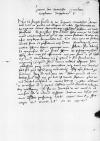Ne tu semper similis es tui, Ioannes Dantisce? Accepi ⌊⌋ tuas, in quibus me ⌊Oedipum⌋ esse iubes. Ego vero utinam tuo erga me amori benevolentiaeque orig. benevolentieque⌈benevolentiaequebenevolentiaeque orig. benevolentieque⌉ respondere possem, non dicam satisfacere! Et prius sane de te hanc spem concepi, ut existimarem nihil omissurum esse, quod in rem meam faceret, et nunc mirifice amplexor benignitatem tuam.
De rebus meis uti scribam nonnihil, facit ratio profectionis meae ad vos. Quandoquidem iam mortua illustrissima ⌊regina principe mea⌋ solutus sum liberque. Et magnifice de me sentit illustrissima domina ⌊Marguarytha⌋ ipsaque citra interpretem affirmavit me non secus a se ⌊caesareae maiestati⌋ commendatum iri, quam optimum e suis familiaribus maximeque praecipuum. Idem Aurei Velleris e written over ad⌈adee written over ad⌉quites, idem nobilissimi quique mihi promittunt neque vanis aut inanibus verbis, sed quod operam quoque meam nonnumquam sibi usui futuram persuadeant. Itaque ad vos paro iter.
Hodie primum ad me delatae sunt ⌊⌋ tuae, qui dies est Martii septimus, plus minus duobus mensibus in itinere orig. itinerae⌈itinereitinere orig. itinerae⌉ detentae. Spero alteras a te missas esse, e quibus ⌊caesareae maiestatis⌋ iudicium et voluntatem intelligam. Tu fac, mi Dantisce, ut me ames, et ad mensem ad te venturum exspecta. Interim non desiste rebus amici[1] consulere prospicereque.
Vale.


 AAWO, AB, f. 10v
AAWO, AB, f. 10v